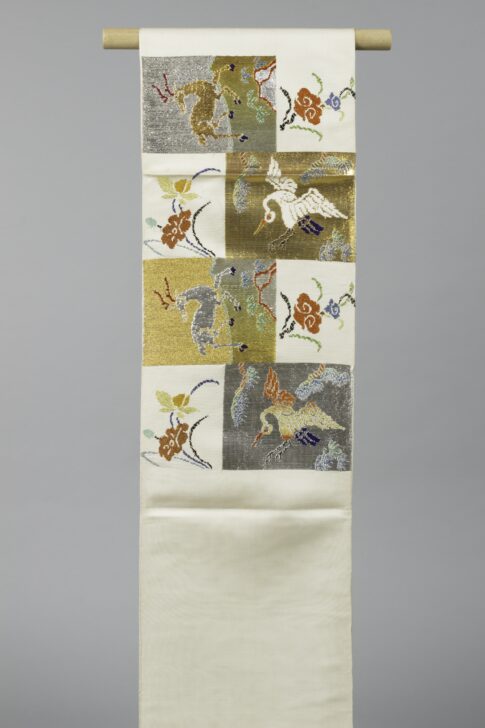Obi
Japanese

Description
Subject Matter:
This is a Nishijin, tsuzure-ori, and maru obi in rokutsuu gara.
Maru obi are the most formal type of obi, having elaborate patterned brocade or tapestry on both sides, typically decorated with rich gold thread. The classic maru obi measures 13inc (33cm) wide. It was most popular during the Meiji (1867-1912) and Taisho period (1912-1925). However, the maru obi is rarely worn today due to its excessive cost and uncomfortable weight.
Nishijin-ori textiles were developed in the Nishijin area of Kyoto city and has dominated the production of high-quality woven textiles since the fifteenth century. The production of Nishijin textiles is very complex and is specialized in five main areas—designing and creating patterns, producing silk threads, producing tools (including weaving machines), weaving, and final sewing—each executed in a different workshop.
Tsuzure-ori, one of the Nishijin textile weave techniques, also known as nail weaving, is a type of tapestry weave that differs from regular loom weaving. Instead of using punch cards as a regular jacquard loom does, tsuzure is woven completely by hand. The design is first laid out on paper, which is used as a guide below the warp. Because the weft is significantly thicker than the warp in this type of textile, the design is visible in the weft and the warp remains unseen. In addition, there are small spaces visible between each thread as the weft does not pass through the entire fabric.
Gara refers to the orientation, arrangement, and surface area of the patterns and pertains to a specific trend and obi tying style.
The Rokutsuu gara type derives from a specific tying style, the Otaiko musubi. The areas of the obi that are visible in this style are patterned while the parts that are obscured are left blank. In terms of surface area, roughly sixty percent is patterned while forty percent is left blank
Physical Description:
off-white maru (double-sided) obi with interwoven and embroidered silver, gold, blue, and orange alternating deer and cranes and orchids, pine.
Usage Rights:
If you are interested in using an image for a publication, please visit https://umma.umich.edu/request-image/ for more information and to fill out the online Image Rights and Reproductions Request Form.